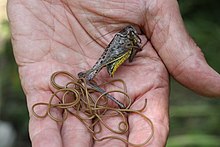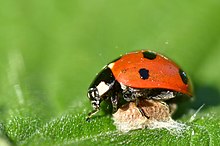Examples
Parasite manipulations can be either direct or indirect. Indirect manipulation is the most frequent method used by behavior-altering parasites, [8] while the direct approach is far less common. Direct manipulation is when the parasite itself affects the host and induces a behavioral response, for example by creating neuroactive compounds that stimulate a response in the host's central nervous system (CNS), a method mostly practiced by parasites that reside within the CNS. [9] Affecting the host's neural system is complicated and manipulation includes initiating immune cascades in the host. [10] However, determination of the causative factor is difficult, especially whether the behavioral change is the result of direct manipulation from the parasite, or an indirect response of the host's immune system. [9] A direct approach to behavioral manipulation is often very costly for the parasite, [9] which results in a trade-off between the benefits of the manipulation (e.g., fitness increase) and the energy it costs. The more common approach for parasites is to indirectly induce behavioral responses by interacting with the host's immune system [8] to create the necessary neuroactive compounds to induce a desired behavioral response. [9] Parasites can also indirectly affect the behavior of their hosts by disturbing their metabolism, development, or immunity. [9] Parasitic castrators drastically modify their hosts' metabolism and reproduction, sometimes by secreting castrating hormones, changing their behavior and physiology to benefit the parasite. [11]
Parasites may alter hosts' behaviors in ways that increase their likelihood of transmission (e.g. by the host being ingested by a predator); result in the parasite's release at appropriate sites (e.g. by changes in the host's preferences for habitats); [12] increase parasite survival or increase the host's likelihood of being infected with more parasites.
Viruses
Baculoviridae
Viruses from the family Baculoviridae induce in their hosts changes to both feeding behavior and environment selection. They infect moth and butterfly caterpillars, who some time following infection begin to eat incessantly, providing nutrients for the virus's replication. When the virions (virus "units") are ready to leave the host, the caterpillar climbs higher and higher, until its cells are made to secrete enzymes that "dissolve the animal into goo", raining down clumps of tissue and viral material for ingestion by future hosts. [13]
Lyssavirus
Rabies is a disease caused by viruses of the Lyssavirus genus, which are released into a host's saliva and transmitted when it comes in contact with an other animal's mucous membranes or open wounds. The disease causes the host to become aggressive and prone to attacking or biting others; this, along with increased salivation, increases the chances of it spreading to new hosts. At the same time, the host experiences hydrophobia (fear of water) [14] and laryngeal spasms, [15] which prevent it from drinking, keeping the virus-laden saliva from being washed down into the stomach or out of the mouth.[ citation needed ]
Protozoal parasites
Plasmodium falciparum
The malaria parasite Plasmodium falciparum , carried by the Anopheles gambiae mosquito, changes its host's attraction to sources of nectar in order to increase its sugar intake and enhance the parasite's chance of survival. [16] It also decreases the host's attraction to human blood while gestating, [13] only to increase it when it is ready to be transmitted to a human host. [13] [17]
Toxoplasma gondii
The protozoan Toxoplasma gondii infects animals from the family Felidae (its definitive host), and its oocysts are shed with the host's feces. When a rodent consumes the fecal matter it gets infected with the parasite (becoming its intermediate host). The rodent subsequently becomes more extroverted and less fearful of cats, increasing its chance of predation and the parasite's chance of completing its lifecycle. [18] There is some evidence that T. gondii, when infecting humans, alters their behavior in similar ways to rodents; it has also been linked to cases of schizophrenia. [19]
Parasitic helminths
Multiple parasites increase their host's risk of predation to facilitate their transition from their intermediate host to their definitive host, including: Euhaplorchis californiensis , [20] Dicrocoelium dendriticum , [20] Diplostomum pseudospathaceum ,[ citation needed ] and Myrmeconema neotropicum. [21]
Dicrocoelium dendriticum

The lancet liver fluke ( Dicrocoelium dendriticum ) is a parasitic trematode with a complex life cycle. In its adult state it occurs in the liver of its definitive host (ruminants), where it reproduces. The parasite eggs are passed with the feces of the host, which then are eaten by a terrestrial snail (first intermediate host). The fluke matures into a juvenile stage in the snail, which in an attempt to protect itself excretes the parasites in "slime-balls". The "slime-balls" are then consumed by ants (second intermediate hosts). The fluke manipulates the ant to move up to the top of grass, where they have a higher chance of being eaten by grazing ruminants. [20]
Leucochloridium paradoxum

The trematode Leucochloridium paradoxum matures inside snails of the genus Succinea . When ready to switch to its definitive host, a bird, the parasite travels to the eye stalks of its host and begins to pulsate, attracting birds with its striking resemblance to an insect larva. [22] It also influences the normally nocturnal snail to climb out into the open during the day for an increased chance of being consumed by a bird. [23]
Microphallus
The parasitic trematodes of the genus Microphallus parasitise the snail Potamopyrgus antipodarum as an intermediate host. The parasites manipulate the snail's foraging behavior to increase the chance of it being preyed upon by the parasite's definitive hosts (waterfowl). The infected snail forages on the upper side of rocks during the period of the day when waterfowl feed most intensely. During the rest of the day, the snail forages at the bottom of rocks to reduce the risk of being eaten by fish (non-host predators). [24]
Nematomorpha
Crickets infected by horsehair worms (Nematomorpha) exhibit light-seeking behavior and increased walking speed, leading them to open spaces and ponds (the surface of which reflects moonlight); the crickets will eventually find and enter a body of water, where the worm will wiggle out of the cricket's abdomen and swim away. While crickets often drown in the process, those who survive exhibit a partial recovery and return to normal activities in as little as 20 hours. [25]
Schistocephalus solidus
Schistocephalus solidus is a parasitic flatworm with three different hosts: two intermediate and one definitive. In its adult stage the tapeworm resides in the intestine of piscivorous birds, where they reproduce and release eggs through the bird's feces. Free-swimming larvae hatch from the eggs, which are in turn ingested by copepods (the first intermediate host). The parasite grows and develops in the crustacean into a stage that can infect the second intermediate host, the three-spined stickleback (Gasterosteus aculeatus). [26] The parasite's definitive host, a bird, then consumes the infected three-spined stickleback and the cycle is complete. It has been observed that S. solidus alters the behavior of the fish in a manner that impedes its escape response when faced with a predatorial bird. [27] This parasite-induced behavioral manipulation effectively increases the chance of it being consumed by its definitive bird host. It has also been observed that the parasite does not induce this behavior until it has reached a developed stage that can survive in the host bird [27] and therefore effectively reduce its own mortality rate, due to premature transmission.[ citation needed ]
Parasitic and parasitoid insects
Ampulex compressa

The emerald cockroach wasp ( Ampulex compressa ) parasitises its host, the American cockroach ( Periplaneta americana ) as a food source and for its growing larvae. The wasp stings the cockroach twice: first in the thoracic ganglion, paralyzing its front legs and enabling the wasp to deliver a second, more precise sting, directly into the cockroach's brain; [28] this second sting makes the cockroach groom itself excessively before sinking into a state of hypokinesia – "a... lethargy characterized by lack of spontaneous movement or response to external stimuli". [29] The wasp then pulls the idle cockroach into its burrow, where it deposits an egg onto its abdomen and buries it for the growing larva to feed on. Keeping the cockroach in a hypokinetic state at this stage, rather than simply killing it, allows it to stay "fresh" for longer for the larva to feed on. [30] The adult wasp emerges after 6 weeks, leaving behind nothing but an empty cockroach "shell". [29]
Dinocampus coccinellae

The wasp Dinocampus coccinellae is both an endoparasite and ectoparasite of ladybugs. The wasp injects an egg into the beetle's abdomen, where the larva feeds on its haemolymph. When grown and ready to pupate the larva exits its host, which remains immobile, and weaves a cocoon on its underside, where it pupates. When a predator approaches, the beetle twitches its limbs, scaring the predator off. This use of the host as a protection has been termed bodyguard manipulation. [31] [32] Similarly, several parasitic wasps induce their spider hosts to build stronger webs to protect the growing parasites. [33]
Hymenoepimecis argyraphaga
The parasitic wasp Hymenoepimecis argyraphaga grows its larvae on spiders of the species Leucauge argyra . Shortly before killing its host the larva injects it with a chemical that changes its weaving behavior, [34] causing it to weave a strong, cocoon-like structure. The larva then kills the spider and enters the cocoon to pupate. [35]
Ophiocordyceps unilateralis
A similar, but much more intricate behavior is exhibited by ants infected with the fungus Ophiocordyceps unilateralis : irregularly-timed body convulsions cause the ant to drop to the forest floor, [36] from which it climbs a plant up to a certain height [37] before locking its jaws into the vein of one of its leaves answering certain criteria of direction, temperature and humidity. After several days the fruiting body of the fungus grows from the ant's head and ruptures, releasing the fungus's spores. [38]
Pseudacteon

Several species of fly in the genus Pseudacteon parasitize fire ants. The fly injects an egg into the ant's thorax; upon hatching, the larva migrates into the ant's head, where it feeds on the ant's haemolymph, muscle and nerve tissue. During this period some larvae direct the ant up to 50 meters away from the nest and towards a moist, leafy place where they can hatch safely. [39] [40] [ dead link ] Eventually the larva completely devours the ant's brain, which often falls off (hence the species nickname: "decapitating fly"). [41] [ dead link ] The larva then pupates in the empty head capsule, emerging as an adult fly after two weeks. [42]
Reclinervellus nielseni
The parasitic wasp larvae Reclinervellus nielseni attach to the spider Cyclosa argenteoalba , releasing substances that modify the spider's web-building behavior so that it weaves a cocoon-like structure for the larvae to pupate in. This manipulated behavior was longer lasting and more prominent the longer the larvae were attached to the spider. [43]
Strepsiptera
Strepsiptera of the family Myrmecolacidae can cause their ant host to linger on the tips of grass leaves, increasing the chance of being found by the parasite's males (in case of females) and putting them in a good position for male emergence (in case of males). [44]
Parasitic crustaceans
Rhizocephala
Members of the order Rhizocephala such as Sacculina carcini alter male hosts' hormonal balance, to encourage nurturing behavior similar to that seen in females. The parasite usually spends its entire life within the host; however, if it is removed from the host in a laboratory setting, male hosts will subsequently grow partial or complete female gonads. [45]









